by “Anonymous”
By HS Board
by “Anonymous”
By HS Board

The Mount Prospect Historical Society has teamed up with the Mount Prospect Community Engagement Committee and the Mount Prospect Public Library, to collect and preserve for the future local memories of the COVID-19 pandemic of 2020-21. The Historical Society and the Library began collecting essays, photos, artwork, news articles and videos via the Historical Society’s website in June and the Village joined the effort in the fall.
This time will go down in history as a momentous one that is hard to forget – like The Great Depression, the World Wars and September 11, 2001. While right now we long to once again walk free and maskless at concerts, sporting events, movies and crowded restaurants, one day we will undoubtedly reminisce about the Year of COVID and relate our shared hardships over holiday dinners to those who don’t remember or were not yet born.
It is important, therefore, that the remembrances conveyed are accurate and not distorted by poor memories. So, they must be preserved now.
The Pandemic Reflections team believes that Thanksgiving presents an ideal time for Mount Prospect residents to begin recording their thoughts, emotions, and memories for posterity. So, the group has posed a question related to the season,
Has COVID impacted your thankfulness this year? How?

. . . and is asking residents and others associated with Mount Prospect to share short thoughts via the “Padlet” board at (https://www.mtphist.org/padlet/).
More substantial entries, such as essays, photos, videos, art and more can be found on our Pandemic Moments page. Also, be sure to watch for new monthly questions starting in 2021 and make contributing your thoughts as an ongoing project.
By HS Board

Welcome to The Chalet! This dollhouse was inspired by Swiss chalet architecture, with a mid-century modern twist. For only $6.99, or $8.94 in the 1975 Sears Wish Book, a child could buy this fully furnished dollhouse. The only catch to this deal is that an adult would have to assemble the fiberboard dollhouse with the included nuts and bolts. The Brumberger Manufacturing Company of New York produced The Chalet and other dollhouse models between 1965 and 1975. Innovations in mass-production just before this time period made this dollhouse more affordable than many of its predecessors.
One of those mid-20th century innovations was the use of plastic furnishings. Plastic furniture, like the pieces here in the living room, could be made on a smaller scale, in more detail, and more consistently than wood furniture. The corner bookcase, with its stack of books clearly visible between two horsehead bookends, is a good example of the new possibilities of plastic.
The kitchen and dining room showcase some late 1960s and early 1970s design trends. The walls of the dining room are covered in wood paneling and matching wall sconces set off the large pastoral painting. All of these elements draw inspiration from Colonial Revival style. The kitchen floor is covered in robin’s egg blue speckled tiles. If this kitchen was life-size, the tiles probably would have been made of vinyl, a newly popular flooring material in the 1960s.
At the top of the modern staircase is the bathroom. The avocado green and golden yellow floor tiles are iconic colors of this era. In a real house, the tiles may have matched the fixtures and even the toilet paper! The bathtub in the corner resembles a hot tub, but it’s actually called a Cinderella bathtub. This compact square style was popular throughout the middle of the 20th century.
One of the most noticeable elements of this bedroom is the striking shade of blue on the walls and carpet. We’ve already seen some bold colors in this dollhouse, but the printed shag carpet makes this room extra stylish by mid-20th century standards. During this carpet’s heyday it showcased the industry advancements that had made wall-to-wall carpeting more affordable and more colorful than ever before.
The roof overhang creates a small shelter on the side of the dollhouse called a carport. It’s not an entirely enclosed space, but it provides a car some protection from the elements and storage for backyard tools. This element is also a Midwestern design feature. Architect Walter Burley Griffin included the first documented carport in the 1909 home of William and Jennette Sloane in Elmhurst.
Thank you for taking a tour of this chalet dollhouse with us! We sincerely appreciate your support for the Mount Prospect Historical Society.
By HS Board

Who will tell Mount Prospect’s story of the Pandemic? The Mount Prospect Historical Society (MPHS) in partnership with the Village of Mount Prospect Community Engagement Committee and the Mount Prospect Public Library have begun a project to collect our residents’ memories and stories of this time in history. Residents and others associated with Mount Prospect are encouraged to submit essays, photos, videos, poems, oral history or other items through the MPHS website. Much is being recorded by national news sources and others; however, we want to create a legacy for future residents to know how Mount Prospect residents specifically lived during this challenging time. Please consider contributing to this important archive.
Neighborhood Walking Tours
The Mount Prospect Historical Society introduced five downloadable neighborhood walking tours this year to entertain those who are increasingly walking and bicycling through town. Get some exercise and learn more about Mount Prospect! And wear a newly designed inspirational MPHS t-shirt to show your pride in Mount Prospect. Download the tours and buy a t-shirt on our website.

By HS Board
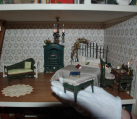
Due to the COVID-19 pandemic, the Mount Prospect Historical Society will replace its annual Housewalk this year with in-depth video tours of six furnished historic dollhouses — five from its collection and one owned by a Mount Prospect resident. The video tour will be available via the Society’s website. This fund-raiser will be available during December and January for a charge of $10, payable through PayPal. Pass the word to dollhouse lovers everywhere since THIS Housewalk can be accessed from anywhere the internet reaches!
By HS Board
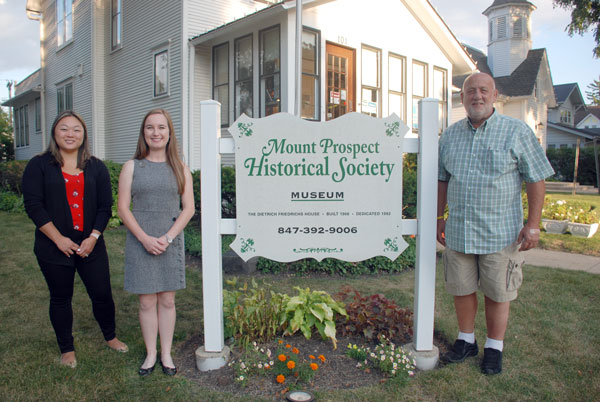
Tom Groenwald, Bookkeeper
Pets: Currently no, but used to have dogs
Kids: Two kids, all grown up and living in the surrounding Chicago
suburbs
Favorite Place in MP: Lou Malnati’s Pizza
Favorite Historical Topic: The Wild West
Favorite Book: Never had time for a favorite book until retirement!
Favorite Movie or TV Show: “Hoosiers” or
“Remember the Titans” are my favorite movies and “Chicago PD” is my favorite TV Show
Favorite Pizza Topping: Black olives
Emily Dattilo, Director
Pets: One adorable Golden Retriever
Kids: None
Favorite Place in MP: Central Continental Bakery. I love their sugar cookies and paczki!
Favorite Historical Topic: Fashion history. I’m endlessly fascinated by what people have worn in different time periods and the underlying significance behind those choices.
Favorite Book: “Pride and Prejudice” by Jane Austen
Favorite Movie or TV Show: “Downton Abbey”
Favorite Pizza Topping: Sausage
By HS Board
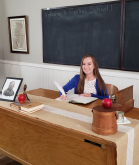
Hello readers! My name is Emily Dattilo and I am the new Director of the Mount Prospect Historical Society. I have been working, volunteering, and interning in museums across Northern Illinois and Wisconsin for years, and most recently I was a Museum Educator at Naper Settlement in Naperville. My new role as Director is especially meaningful to me because Mount Prospect is my hometown. Now I have the opportunity to care for and share the history of my own community. It is a rare privilege to be able to serve my community in this way.
The COVID-19 pandemic has made for an extra challenging start to my time at MPHS. With three new staff members we’ve been adjusting to not just a new workplace, but the “new normal” of social interactions. We’ve moved our desks to socially distant locations, increased office cleaning, and are wearing masks while working. Networking, when possible, has been strange too. Awkward waves have replaced hearty handshakes, and it’s much more challenging to remember faces when you only see eyes and eyebrows. While many things are unknown right now, know that all of us at the MPHS are doing our best to continue sharing local history with you in new ways.
However much life has changed in 2020, nothing has changed my excitement over diving deeper into local history. Even though I’ve lived in Mount Prospect my entire life, each day here has brought a new, sometimes surprising, insight into my town’s past. I’m enjoying learning more about my community.
I look forward to meeting you all in person one day. Say hello if you see me in the neighborhood!
By HS Board
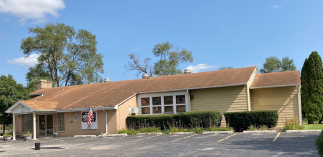
By Jean Murphy
The unassuming brick and mustard-colored structure on the east side of Route 83 at East Highland Street has housed the local Moose Lodge since 1983, but it played an even more vital role in the Mount Prospect of the 1950s, 60s and 70s when it was the headquarters of VFW Post 1337.
Local World War II veterans (with the help of a few World War I vets) constructed the clubhouse themselves between 1949 and 1950. The local Post had been chartered in 1925 and originally met in a farmhouse at 51 N. Wille Street, which has since been torn down. In the 1920s this meeting place was on the outskirts of town; there is even an advertisement in The Herald for a trap shooting event at the Post in 1927. Then, in 1933 they moved to the old John Katz farmhouse at the corner of Elmhurst Avenue and Memory Lane, which burned in 1975.
Over the years Post 1337 contributed to the community, donating elm trees to be planted along Main Street and flagpoles and even a trench mortar from World War I to be placed in front of Village Hall.
But when there was a fresh influx of former GIs from the Second World War, Post 1337 realized that they needed a larger clubhouse. Fortunately, property at 601 N. Main Street was donated, purportedly by a member of the Busse family (but since we can’t currently access Torrens records in the County Building, we can’t be sure which one). The property included the large parcel we see today, as well as the land which now holds the water tanks of the Illinois American Water Company. The VFW donated a portion of their land for that public interest purpose in 1964.
Veterans from both wars worked on the new structure for a full year. “Everyone pitched in their skills,” according to Bob McKillop who served in the Air Force during both Korea and Vietnam.
“Members wanted the interior to tie in with the Tudor-style décor in downtown Mount Prospect, so they designed the bar with a Tudor look. The beautiful, elaborate bar features curved wood and railings, built by VFW members. The members also used pulleys and hoists to place the distinctive roof beams – done like an Amish barn-raising! Outdoors the building was designed so the front would blend in with the houses farther south on Main Street, because the veterans did not want the VFW to look like a commercial building,” McKillop continued.
“The WWI and WWII guys worked together on the project. They were committed to building their own home in town, so they didn’t refuse to do anything, And, there IN THIS ISSUE: were so many of them. Twenty percent of the population had served,” he added.
It is important to remember that when they were constructing the clubhouse, this was very much the edge of town. Randhurst had not yet been built. The VFW clubhouse was one of Mount Prospect’s only community gathering places!
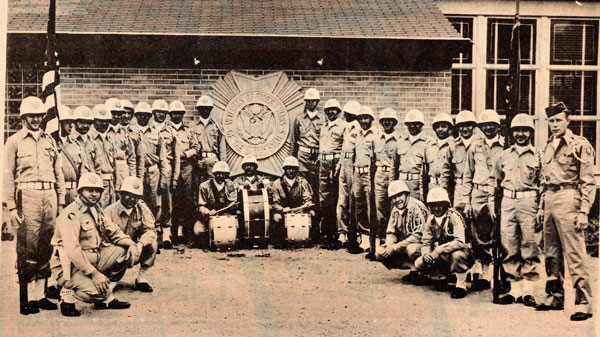
On the nights of VFW meetings (which often attracted 40-50 members at a time), only VFW members were welcome at the Hall, but other nights it was open to the public. The back room had a small stage which was used for amateur shows and bands hired for dances. The Hall was rented for weddings (including the 1955 wedding of Wayne Busse and Grace Rapp), banquets, birthday parties, high school parties and much more. The veterans used the space for Memorial Day and Veterans Day gatherings, bingo games, fund-raising dinners and much more.
The kitchen is in the basement and next to it there was a small room with a fireplace which was used for small VFW meetings. Often, they didn’t want to spend the money to stoke up the boiler for heat, McKillop recalled.
The VFW Women’s Auxiliary played a pivotal role in running and maintaining the VFW Hall. They were the “unsung heroes” who held fish frys, picnics, dinners, bake sales and more and largely carried the VFW Hall’s maintenance costs for many years.
And whenever the Hall needed maintenance, members stepped up. McKillop remembers 30 guys showing up to scrape and paint the Hall’s exterior when necessary.
Mount Prospect Trustee Mike Zadel managed the Hall from 1972 to 1974. He was only in his 20s at the time and had never served in the Armed Forces, but he worked 12 hours a day, seven days a week.
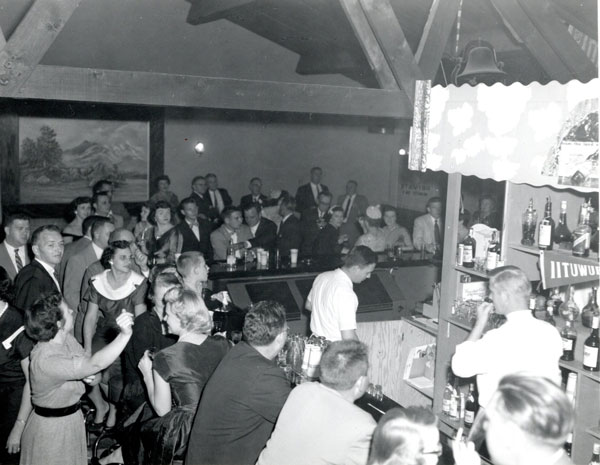
In those days the World War I and II veterans were passing away or becoming less active, so the VFW couldn’t get enough volunteers to run the place and had to hire outside management. The veterans continued to host fundraisers like the Friday fish frys and Tuesday bingo, but leased the building to others for the day-to-day operations. The lessees served refreshments and bar food. The lessees supplemented their income by renting the back room for parties (including the 25th anniversary party of Mayor Bob Teichert and his wife, Alice, in the mid-1970s), small weddings, quinceañeras, funeral lunches etc.
At that time there were no women members, but men from outside the VFW ranks were permitted to join as social members for $15 per year.
The bar attracted between seven and 20 people most nights, but Friday nights were busy, attracting 40 to 45 people. “The social members kept it going in those days,” Zadel said.
In early 1983 the VFW sold the building to Moose Lodge 660, but they returned twice a month for meetings until they found a different meeting place.
The VFW has recently chosen to hold their meetings back at their former home at the current Moose Lodge.
To view this year’s Veteran’s Day ceremony live, tune in at 10 a.m., November 11 to the Village web-site or Channel 17 on Comcast or WOW or for delayed viewing visit the Village of Mount Prospect’s YouTube channel.
Mount Prospect Historical Society
101 South Maple Street
Mount Prospect, IL 60056
847.392.9006
info@mtphistory.org
The Mount Prospect Historical Society is a 501(c)(3) nonprofit organization that is committed to preserving the history of Mount Prospect, IL, through artifacts, photographs and both oral and written memories of current and former residents and businesspeople. On its campus in the heart of the Village, the Society maintains the 1906 Dietrich Friedrichs house museum, the ADA-accessible Dolores Haugh Education Center and the 1896 one-room Central School, which was moved to the museum campus in 2008, renovated and opened to the public in 2017, the 100-year anniversary of the Village.